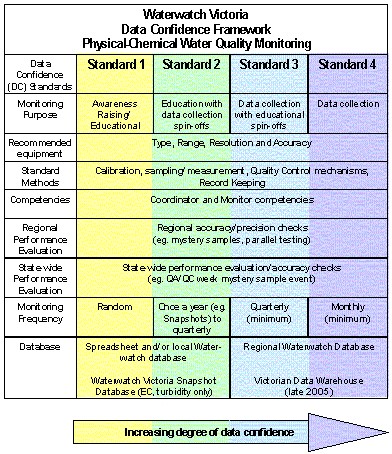Data confidence and interpretation
Data confidence
How does Waterwatch Victoria support the collection of credible data?
The Waterwatch Victoria Data Confidence framework informs users of Waterwatch data of the breadth of monitoring purposes across the program. It is designed to introduce users of data to the wide range of monitoring purposes.
It is intended to be a quick guide categorising Waterwatch monitoring programs into four standards, based on monitoring objectives. Waterwatch groups with similar monitoring objectives share a similar interest in how data is gathered, stored and used.
In developing a state framework based around monitoring purpose, river health data collected under different Waterwatch programs can be recognised and valued, for its contribution to education, as well as to natural resource management.

Complementing the Data Confidence Framework are the Data Confidence Guidelines, which have been developed for specific water quality parameters.
These parameter-specific guidelines were developed to identify minimum criteria for the four standards identified in the Framework.
Regional Waterwatch coordinators use the guidelines when developing regional Data Confidence Plans to identify the interest and capacities of their regional program. Determining how and where existing (and new) monitors fit within the new data confidence framework is made through discussions with monitors and a review of their monitoring objectives and plans.
This interactive process is important to ensure that a monitor's time and effort is appropriately reflected in their selected standard level. It also allows Waterwatch Coordinators to be clear about the needs and wants of a monitoring group they are supporting, particularly in terms of data availability and access.
Access the Waterwatch Victoria Data Confidence Guidelines.
Data interpretation
To maintain a rigorous understanding of the health of Victoria's waterways, Waterwatch provides resources in the areas of data interpretation and monitoring.
 Access the Waterwatch Data Interpretation Manual.
Access the Waterwatch Data Interpretation Manual.

